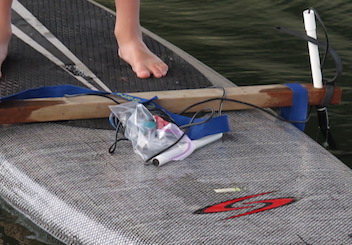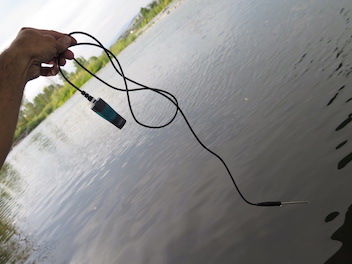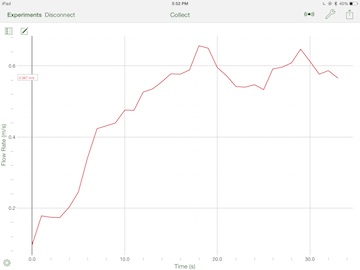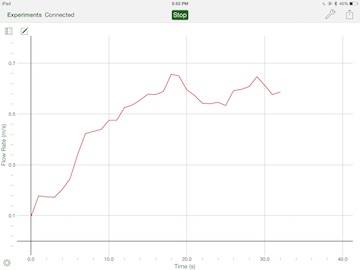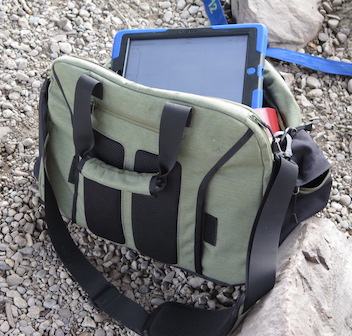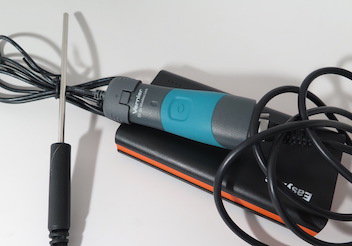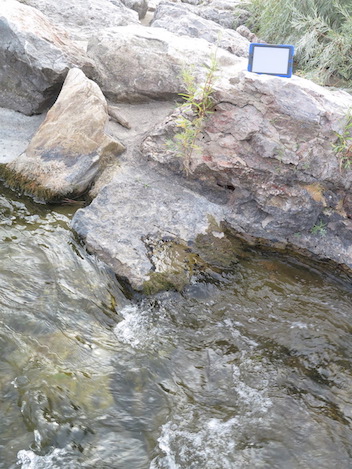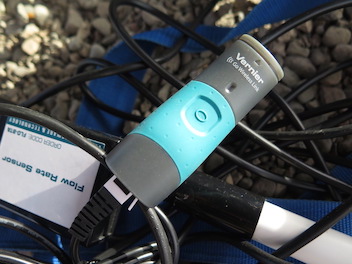
Vernier’s new Go Wireless Link is a small but effective solution to expand the scope and reach of over 40 sensors. Using a Bluetooth bridge between sensor and computer or tablet, and a usable range extending up to 30 meters, the Go Wireless Link provides an upgrade to existing sensors and a new frontier in what’s possible in data collection. For example, the increased distance between the sensor and student is helpful for many reasons including experimental opportunity, safety, and when measuring physical parameters inside a sealed container.

Bluetooth is an ultra short wavelength radio transmission of limited range. The 2.4 to 2.485 GHz electromagnetic waves are quite sensitive to interference from metal and other objects in the line of sight between transmitter and receiver.
As high tech as Bluetooth is, the name actually was taken from a Scandinavian King a thousand years ago.
King Harald Bluetooth likely had a conspicuous dental issue that resulted in a black tooth. The moniker “blue” meant dark back then. Bluetooth was chosen for reasons beyond the fact that Ericsson and Nokia (both Scandinavian companies) were instrumental the adoption of the Bluetooth standard. There is actually symbolism behind the name in that King Bluetooth unified Norway and Denmark and so does the Bluetooth wireless technology unites phones with computers (in 1995), and today Bluetooth unifies pretty much everything with anything else. Further, the logo and taskbar icon for the Bluetooth standard is a nod to King Bluetooth with the nordic runes of his initials of H and B.

The finger-sized Go Wireless Link uses the same successful design as
other Vernier wireless sensors including the
Go Wireless Temp and
Go Wireless pH. For me, the proprietary charging interface is a mixed blessing. On one hand it provides a degree of security and durable simplicity necessary for classroom use. On the other, it the Go Wireless transmitter must be accompanied with its own special charging cable. Having carried the Go Wireless Link on several field adventures, on more than one occasion I used up the battery on the Go Wireless Link (which does take effort), but left the charging cable back on the lab bench.
Big Stuff
I’ve often wondered when popular culture will transition off the initial name of technology that stemmed from what it isn’t rather than for what it is. Wireless is without wires, yet in many uses of Bluetooth there was never a wired option in the first place. And worse, students today have lived their entire lives only experiencing the wireless version of the once-wired device.
By increasing the separation between measurement and recorder, the Go Wireless Link allows for greater motion due to the missing wires. In a similar leap of options, battery powered LED microscopes moved the function of the self-illuminated microscope more than two meters from the nearest outlet.
But Does It Hold Water?
For example, in order to measure the water speed of a paddle boarder, it was possible to use the flow meter attached to the paddle board transmitting the speed to the receiving iPad on shore. Moving upstream on a river, it was possible for the observer to walk the shore with the iPad collecting speed data as long as the sensor was within its ample range.
Stroke impulse was also easily measured with the speed changing slightly throughout the paddling motion. If one wanted to do some serious analysis, it would be possible to find the most efficient stroke to move the paddle board the fastest.
Resolution
Tiny multicolored LED lights in the center of the main face of the Go Wireless Link provides all the necessary feedback to the user. The light is blue when charging, and goes out when fully charged. A flashing red light indicates the Go Wireless Link is on and ready to pair. Blinking green means the Go Wireless Link is paired and connecting data. And no light means the sensor is off or the battery is dead. The sole control button lies in the center of the face. The north end of the interface connects to power, while the southern end is a receptacle for appropriate Vernier sensors. Of course there really is particular orientation to the Go Wireless Link, so the coordinates were aligned with Vernier’s logo.
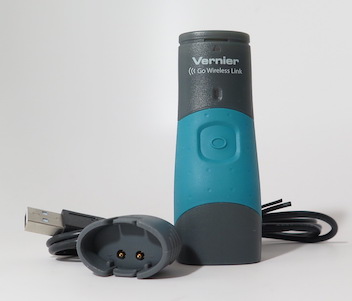
The Go Wireless Link takes about two hours to charge, but the discharge rate depends on the sensor used since the internal 250 mA Lithium Ion battery powers both the Bluetooth transmitter and the particular sensor connected to it. And since different sensors have different power requirements, the battery runtime varies, but always seems to be measured in hours. For field work, you can charge the battery using its special cable and almost any external cell phone battery. In fact there should be plenty of charges within of a quality external battery since the 250 mA Lithium Ion battery draws only about one-seventh the power of an iPhone 6.
For those power-hungry or long-term data collections, I found the Go Wireless Link could both transmit data and be charged at the same time. I don’t know if there are any limits to the transmitting time or the X-axis on the default App screen but with external power, it’s conceivable that the Go Wireless Link could broadcast forever.
The sensor must talk to something and at the moment that includes the App named Graphical Analysis (available both on Google Play and the iOS App Store), and Vernier’s LabQuest App. Reading between the lines, this means that the Go Wireless Link works with iPads, iPods and iPhones running new enough software, as well as current Android tablets and phones. Check
Vernier’s website to see if your device is Go Wireless Link-ready.
Resolve This
The Go Wireless Link has a 12-bit resolution. This means that 4096 or 212 different numbers can be converted from analog to digital. This resolution does not always mean you get 4000 choices, since it may take several numbers to indicate one data point. But for argument’s sake, we’ll do our calculations assuming one-to-one. And then there is the issue of data range. 12-bit seems plenty for this interface given the sensors it attached to, the software it talks with, and the nature of the data being collected. For instance, A 100 degree temperature range measured to the tenth of a degree would require 1000 possible values. A 400 degree range to the tenth would need 4000. And a 50 degree range to the hundredth of a degree would require 5000 possible values. Vernier’s interfaces address the resolution in a creative way by scaling the sensor’s accuracy with its resolution. For instance, the stainless steel temperature sensor varies its resolution according to temperature range along this scale: 0.17°C from –40 to 0°C; 0.03°C from 0 to 40°C; 0.1°C from 40 to 100°C and 0.25°C from 100 to 135°C. This translates to 235+1333+600+140 possible data points, or 2308 which is well below the 4096 resolution of the interface.
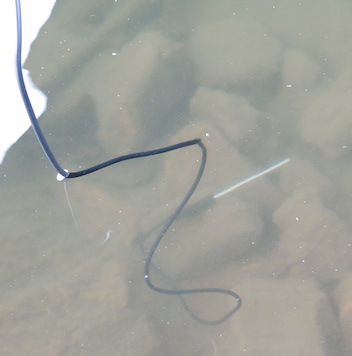

Extended Range
The Go Temp wireless sensor is an excellent tool as long as the measurement can be made within 11.5cm of the sensitive electronics. By using the Vernier’s standard stainless steel temperature sensor connected to the Go Wireless Link it is possible to get a wireless temperature reading 1.65 meters from the transmitter. Having well over a meter to play with gives plenty of safety for student and equipment. It also affords over a meter and a half of underwater temperature measurements which will capture local
thermoclines.
But You Can See It From Here.
Although King Harald’s influence was extensive, the Go Wireless Link Bluetooth transmitter is limited to a air-filled sphere with a 30 meter radius. Anything but air diminishes the reach. As a test of the transmitter’s range, a paddle boarder slowly moved away with the flow sensor attached. An iPad collecting data remained on shore next to a Leica laser rangefinder. At the moment the signal was lost, the distance was measured. A full 30m was never reached, but a consistently strong signal was possible line-of-sight out to 27 meters. The missing three meters could be from the alignment of the iPads antenna or possibly the heavy iPad case. Either way, 27 is a good number.

Different materials have different effects on the Bluetooth signal. Metals are often deal killers for transmission, but other materials like plastic, glass, rubber, and wood have limited effect on the signal. Sometimes when metal is involved, if the connection is established between sensor and computer before the metallic barrier is in place, there seems to be a more robust connection between the two than when metal is encountered first.
But what would you put the sensor in? Say, for instance you wanted to insert a sensor into an inner tube that would then be inflated with a pump. The Go Wireless Link would have no trouble firing its wave/particle duality through the soft material. But if per chance you wanted to use a sensor within a metal container like a drum or garbage can, it might work, but most likely not.
Another application of safe distance between sensor and tablet is if one wants to wade out into fast currents to measure the speed of the water. With the iPad facing the user, it is possible to see the results on the screen when out in the river with the sensor.
The river that runs through my town (and happens to have the original “
A River Runs Through It” join this river upstream) is also home to
some manufactured waves. The standing waves are playgrounds for kayakers, surfers, paddle boarders, and other explorations in freshwater hydraulics. A lesson plan that has been rolling around in my mind is to attempt to measure the forces at work and quantify the events involved in riding a river wave. This would be especially topical giv
en the popularity of river surfing with high school students, and that another set of waves is planned in the river.
The “wave” is actually a complicated set of events that produces forces of different levels and directions. And like a skateboard park or roller coster, surfing a wave requires a complex dance balancing and unbalancing the forces. Having some data will put face on what’s actually happening. And using sensors to measure wave parameters is a great start.
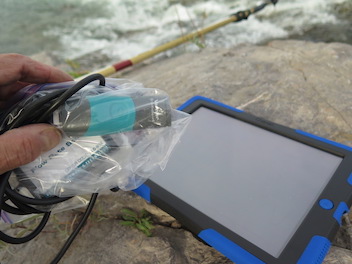
Vernier’s free App called Graphical Analysis makes an excellent interface with which to capture and present data. Its uncluttered and autoscaled projection is powerful yet intuitive. Graphical Analysis uses obvious finger gestures to manipulate the graph making it lightening fast to inspect measurements on the fly, and dropdown-like menus appear when necessary. I’ve taken to grabbing screenshots of the graph as needed using the iPad’s built-in feature of capturing the screen at the push of its home button and I/O button at the same time. Data collection is not interrupted, and the images are immediately available for sharing and use within other apps like
Explain Everything and Google Docs.
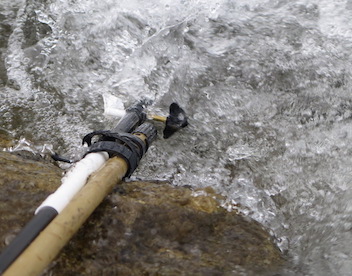
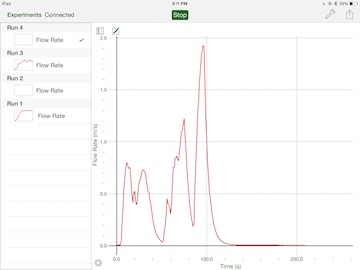
Whether you use the Go Wireless Link as a basic interface, or capitalize on its extended range, the world of rapid data collection just keeps expanding. The wireless students in today’s classrooms are not bound by the self-imposed limits of technology due to past experience. They expect to do everything and have it work 100% of the time. And the more I use the Go Wireless Link, the more I think they are right in their expectations. We should not require students to fight with marginal technology that steals time and effort from the instructional process. The limits of technology are not fixed. Instead they are dynamic limits that move forward every semester. And the Go Wireless Link is definitely one of those leaps forward. A giant leap in fact.





